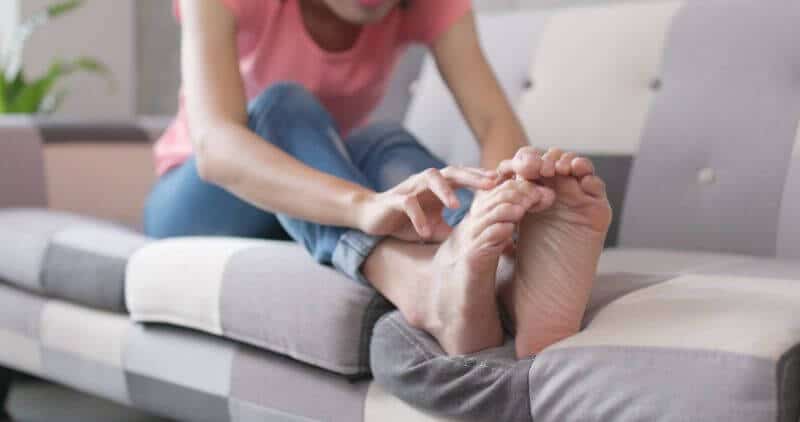Also known as dermatitis, eczema affects roughly one in five adults and up to a fifth of all UK children. It can appear anywhere on the body, but it’s common on feet, toes and lower legs.
The main symptoms of eczema are dry and itchy skin, which can flake and crack. This often leads to blisters, rashes and even ulcers – an irritating and painful situation. Any abrasion in the skin provides a point of entry for germs to creep in, so even mild eczema shouldn’t be ignored.
Main Types of Eczema
Atopic Dermatitis
This is the most common form of eczema – it usually affects children and occasionally teens. Atopic dermatitis can be very uncomfortable, with dry, sore, and inflamed skin underneath the foot, on the heel and around the toes. It’s also extremely itchy.
The precise cause is uncertain, but a genetic link is probable as it’s common for sufferers and their parents to also have asthma or hay fever.
Discoid Eczema
Characterised by circular groups of red or brown spots, discoid eczema is more common in adults. Typically, the spots become inflamed and tend to weep. This form of eczema isn’t always itchy, although any itchiness tends to be severe.
This is the only form of eczema that doesn’t have a hereditary cause. Instead, it can be triggered by inflammation in other parts of the body, blood flow issues or skin damage such as insect bites. Discoid eczema usually clears up, although this can take several months. Happily, it doesn’t usually reoccur.
Contact Dermatitis
An adverse reaction to everyday items can lead to contact dermatitis. Irritant contact dermatitis can be caused by products such as shower gels or soap. Allergic contact dermatitis arises from contact with certain materials – leather or wool, for example.
Contact dermatitis is often characterised by red and itchy pus-filled blisters.
How to Treat Eczema
There is no cure but understanding how attacks are triggered allows you to manage the condition. Triggers are different for everyone, but with the guidance of a podiatrist you can identify the warning signs specific to you.
If eczema does flare up, consider your circumstances at the time. What were you wearing or eating, were you stressed, what was the weather like, and so on?
Common Triggers
Allergies and Irritants
These can include certain fibres or washing products, foods such as peanuts or cow’s milk, dust mites, pollen, and eggs.
Hormones
Ladies can be particularly susceptible prior to their periods or when they are pregnant.
Stress
A very common eczema trigger.
Damp Feet or Friction
Leaky footwear or woollen non-breathable socks will make your feet damp on a regular basis, and eczema thrives in these conditions. Friction from poorly fitting shoes or socks can also encourage eczema to break out.
Weather
Cold weather leads to itching, flaking and blisters.
How to Alleviate the Symptoms
Always Moisturise Your Feet
After bathing use a rich, non-perfumed moisturiser (not between the toes). Do this even if your feet seem fine. Well-hydrated feet are far less likely to flare up.
Manage Stress
Reducing stress levels will work wonders – to keep eczema at bay and for your health in general. Gentle stretching, easy walking, listening to music or meditating – try different things to discover what works for you.
Reassuring Help – Ask One of Our Experts
At Feet By Pody, we’ll help you find the right way to manage your eczema. And if the worst happens, we can advise on over-the-counter remedies such as corticosteroid ointments, antihistamines and emollients (medical moisturisers).

